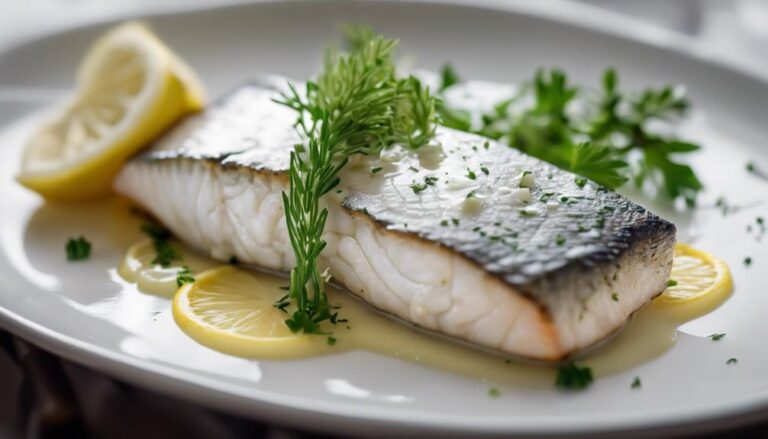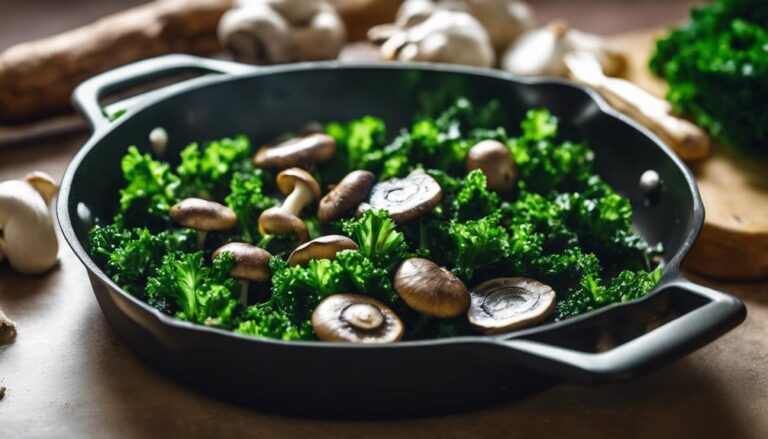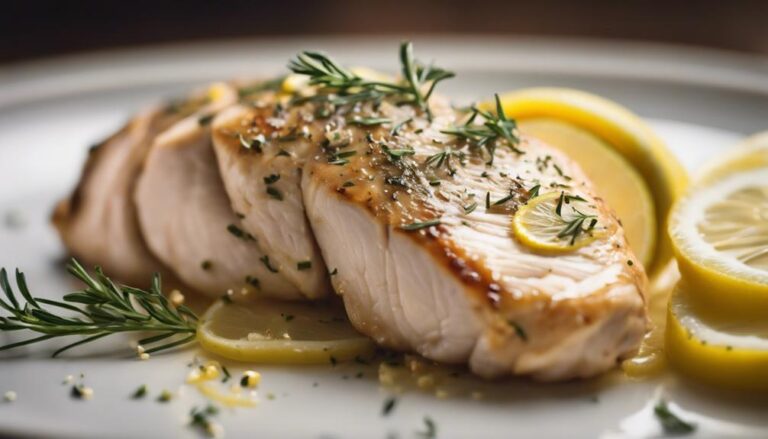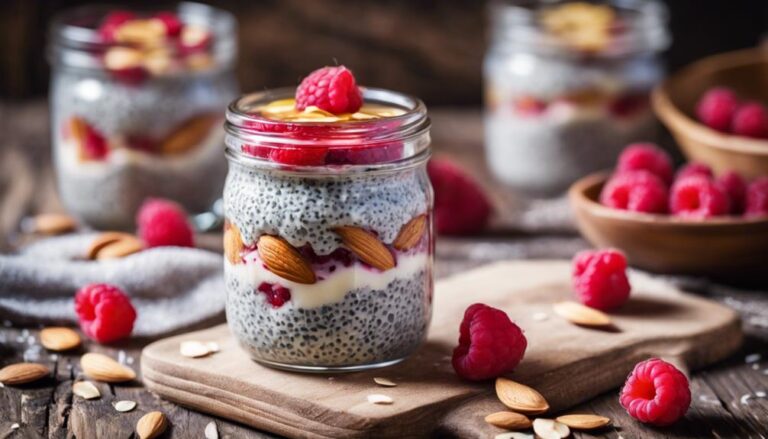Stuffed Bell Peppers With Quinoa and Turkey
If you're looking for a nutritious and tasty meal, try making stuffed bell peppers with quinoa and turkey. This protein-rich twist on a classic dish is both satisfying and delicious. Fill the peppers with a mixture of cooked quinoa and ground turkey seasoned with herbs and spices. Bake until the peppers are tender and the filling is cooked through. The combination of flavors and textures is sure to please your palate. And if you want to enhance this dish further, there are many creative variations and techniques to explore for even more culinary enjoyment.
What You Will Learn Here
- Quinoa adds protein and texture to the stuffing.
- Turkey provides a lean and flavorful protein source.
- Balanced combination for a nutritious meal option.
- Ideal for a healthy and satisfying meal.
- Fusion of flavors for a delicious stuffed pepper dish.
Origins of Stuffed Peppers
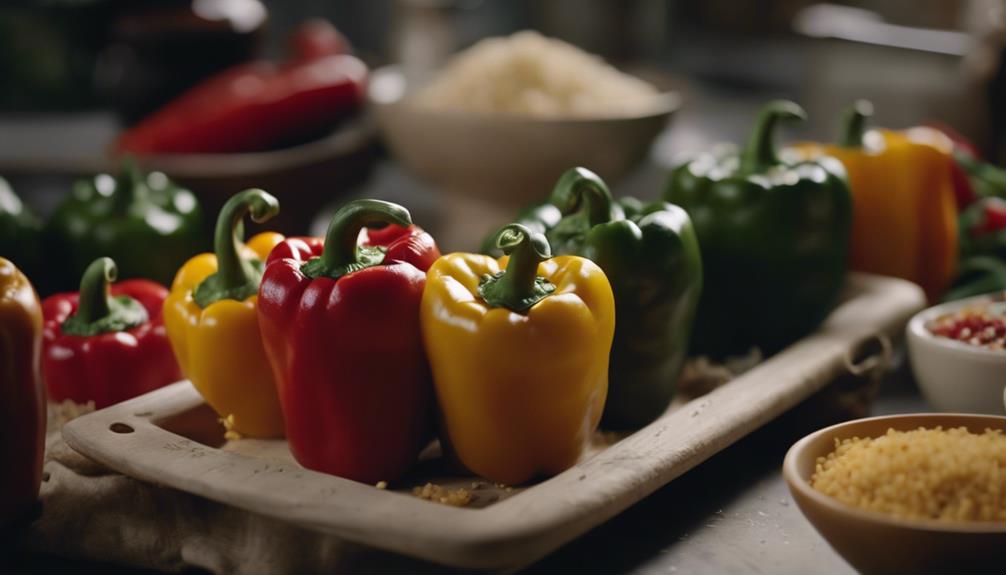
The historical origins of stuffed peppers trace back to ancient civilizations, showcasing a rich culinary heritage.
Various cultures have put their unique twist on the stuffing, leading to a diverse range of flavors and textures.
Over time, stuffing recipes have evolved, adapting to different ingredients and cooking techniques.
Historical Origins of Peppers
With roots dating back thousands of years, peppers have a rich and diverse history that influenced the creation of stuffed peppers. Pepper cultivation began in Central and South America, with varieties such as bell peppers, jalapeños, and poblanos being cultivated by ancient civilizations like the Mayans and Aztecs. These peppers weren't only valued for their flavors but also for their medicinal properties. As trade routes expanded, peppers made their way to Europe and Asia, where they became integral to various cuisines, adding heat and flavor to dishes. The culinary influence of peppers spread globally, leading to their incorporation in diverse recipes.
Peppers played a significant role in the development of stuffed peppers, with their unique flavors and shapes making them ideal vessels for filling with grains, meats, and spices. The history of peppers intertwines with the evolution of stuffed peppers across different cultures, showcasing the versatile nature of this dish. The origins of stuffed peppers are deeply connected to the cultivation and culinary significance of peppers throughout history.
Cultural Variations in Stuffing
Exploring the diverse cultural variations in stuffing reveals the rich tapestry of flavors and traditions that contribute to the origins of stuffed peppers. Cultural adaptations play a significant role in the stuffing of bell peppers, with each region infusing its unique twist into this classic dish.
For example, in Mediterranean cuisine, you may find peppers stuffed with a mixture of rice, pine nuts, and raisins, reflecting the region's preference for combining savory and sweet flavors. In Mexican cuisine, peppers are often filled with a mix of ground meat, rice, and spices, showcasing a spicy and bold flavor profile.
Regional preferences also influence the choice of ingredients used for stuffing. In Eastern European countries like Hungary, peppers are commonly filled with a hearty mixture of meat and rice, seasoned with paprika for a robust taste. On the other hand, in Middle Eastern cuisine, you might encounter peppers stuffed with a fragrant blend of couscous, lamb, and aromatic spices like cumin and cinnamon, emphasizing the region's love for intricate spice combinations. These cultural variations highlight the versatility and adaptability of stuffed peppers across different culinary traditions.
Evolution of Stuffing Recipes
Uncover the fascinating journey of how stuffing recipes for bell peppers have evolved over time. The evolution of stuffed peppers reflects changing trends in cooking techniques and flavor combinations. Initially, stuffed pepper recipes were simple, consisting of basic ingredients like rice, ground meat, and herbs. Over time, as culinary skills advanced and global influences spread, the stuffing recipes became more diverse and creative.
In the past, traditional recipes focused on ingredients readily available in specific regions, resulting in distinct variations. However, with increased connectivity and cultural exchange, modern stuffed pepper recipes now incorporate a wide range of flavors and cooking methods. From Mediterranean-inspired quinoa and feta cheese fillings to Asian-inspired ginger and soy-infused mixtures, the evolution of stuffing recipes has become a fusion of culinary traditions.
Today, the versatility of stuffed bell peppers allows cooks to experiment with different ingredients and techniques, creating unique and innovative combinations. Whether baked, grilled, or slow-cooked, the evolution of stuffing recipes continues to push boundaries and delight taste buds with its endless possibilities.
Key Ingredients for Flavor
For a burst of flavor in your stuffed bell peppers, focus on selecting the freshest ingredients. To elevate the taste of your dish, consider these key ingredients for flavor:
- Fresh Herbs: Chop up some fragrant basil, parsley, or cilantro to infuse your peppers with a burst of freshness.
- Garlic: Mince or press fresh garlic cloves for a savory and aromatic addition to your filling.
- Onion: Dice and sauté onions until caramelized to add a subtle sweetness and depth of flavor.
- Tomatoes: Use ripe, juicy tomatoes to bring a touch of acidity and brightness to your dish.
- Spices: Experiment with a blend of cumin, paprika, and red pepper flakes to create a flavorful and well-balanced seasoning mix.
Top Stuffed Pepper Variations

Looking to add some flair to your stuffed pepper game? Try out variations like Quinoa and Turkey Stuffing for a protein-packed option.
A Mediterranean-inspired recipe offers a burst of fresh flavors. Add a unique twist with Apple Cider Vinegar to elevate the taste profile.
These variations offer a range of different tastes and textures to keep your stuffed pepper meals exciting and delicious.
Quinoa and Turkey Stuffing
To enhance your stuffed bell peppers, consider preparing a flavorful Quinoa and Turkey stuffing. Quinoa, known for its numerous health benefits, pairs excellently with the lean protein of turkey. Here are five key points to help you perfect your Quinoa and Turkey stuffing:
- Quinoa Benefits: Quinoa adds a nutty flavor and a delightful texture to the stuffing, while also providing a good source of protein and essential nutrients.
- Turkey Pairing: The turkey complements the quinoa by adding a savory taste and moistness to the stuffing, creating a well-balanced dish.
- Cooking Techniques: Sauté the turkey with onions and garlic before adding cooked quinoa to enhance the flavors and guarantee even distribution of ingredients.
- Flavor Combinations: Consider adding herbs like parsley, thyme, and a hint of lemon zest to elevate the taste profile of the stuffing.
- Texture Balance: Achieve the perfect balance of moisture by incorporating a bit of broth or tomato sauce while mixing the quinoa and turkey for a deliciously moist stuffing.
Mediterranean-inspired Stuffed Pepper Recipe
Consider incorporating Mediterranean-inspired flavors into your stuffed pepper recipe for a delicious twist on a classic dish. Mediterranean flavors bring a burst of freshness and healthiness to your meal. Here are some healthy alternatives to traditional stuffed peppers that you can try:
- Use feta cheese and olives for a tangy and salty kick.
- Incorporate fresh herbs like oregano, basil, and parsley for a fragrant aroma.
- Add diced tomatoes and cucumbers for a juicy and invigorating element.
- Swap traditional rice for quinoa or bulgur for a protein-packed and fiber-rich option.
- Drizzle with extra virgin olive oil and a squeeze of lemon for a Mediterranean touch that enhances the flavors.
These Mediterranean-inspired additions will elevate your stuffed peppers, making them not only tasty but also a nutritious meal option. Try experimenting with these ingredients to create a unique dish that's both satisfying and good for you.
Apple Cider Vinegar Twist
Enhance your stuffed bell peppers with a zesty Apple Cider Vinegar twist for a flavorful variation on this classic dish. Apple Cider Vinegar not only adds a tangy kick but also provides several vinegar benefits, enhancing the overall nutritional profile of your meal. Here are some recipe tips to make the most of this ingredient:
- Drizzle a mixture of Apple Cider Vinegar, olive oil, and honey over the stuffed peppers before baking for a caramelized glaze.
- Sprinkle a pinch of red pepper flakes into the vinegar for a spicy twist that complements the sweetness of the peppers.
- Marinate the turkey filling in Apple Cider Vinegar, garlic, and herbs for an extra burst of flavor.
- Use Apple Cider Vinegar to deglaze the pan after browning the turkey to infuse the dish with rich, savory undertones.
- Finish the stuffed peppers with a sprinkle of fresh herbs and a splash of Apple Cider Vinegar just before serving for a bright and vibrant taste.
Experiment with these flavor pairing ideas and cooking techniques to elevate your stuffed bell peppers to a whole new level of deliciousness.
Pepper Roasting Techniques
When roasting peppers, consider roasting them whole or cutting them before roasting, each method offering unique flavors and textures.
You can roast peppers in the oven for a smoky taste or use the stovetop for a quicker, more charred finish.
Experiment with both techniques to discover your preferred way of roasting peppers for your stuffed bell peppers recipe.
Roasting Peppers Whole
To achieve a delicious smoky flavor in your stuffed bell peppers, consider roasting the peppers whole using various techniques. Roasting whole peppers enhances their natural sweetness and adds a depth of flavor to your dish. Start by preheating your oven to 400°F (200°C). Place whole bell peppers on a baking sheet and drizzle them with olive oil, then season with flavorful seasonings like salt, pepper, and garlic powder. You can also experiment with alternative stuffings like different types of cheese or grains for a unique twist.
Another method to roast peppers whole is by using a gas stove. Simply place the whole peppers directly on the burner over medium-high heat. Rotate them occasionally with tongs until the skin is charred and blistered all around. This technique imparts a smokier flavor to the peppers. After roasting, let the peppers cool before peeling off the skin, removing the seeds, and preparing them for stuffing. Roasting peppers whole is a simple yet effective way to elevate the taste of your stuffed bell peppers.
Cutting Peppers for Roasting
Once you have roasted the whole bell peppers to enhance their flavor, the next step is to efficiently cut them for stuffing. When it comes to pepper slicing after roasting, it's important to handle the peppers with care to preserve their shape and make sure they're ready for the flavorful stuffing. Start by gently removing the stem of the roasted pepper and then carefully cut around the top to create a wide opening for easy stuffing access. After opening up the peppers, make sure to remove the seeds and membranes inside to provide ample space for the delicious quinoa and turkey mixture.
When it comes to techniques for cutting peppers for roasting, precision is key. Use a sharp knife to slice the peppers evenly, ensuring that they'll cook uniformly and look visually appealing once stuffed. Take your time to slice the peppers with steady hands, making sure not to tear the tender roasted flesh. By mastering the art of pepper slicing after roasting, you'll be well on your way to creating beautifully stuffed bell peppers that are as visually pleasing as they're delicious.
Oven Vs. Stovetop Roasting
For peak flavor and texture in your stuffed bell peppers, consider the differences between oven and stovetop roasting techniques. When it comes to oven roasting, the peppers are cooked at a consistent temperature, allowing for even cooking and caramelization. This method brings out the natural sweetness of the peppers, enhancing their flavor profile.
On the other hand, stovetop roasting involves cooking the peppers over direct heat, which can result in a quicker cooking time but may lead to uneven roasting.
The pros of oven roasting include a more consistent and controlled cooking environment, ideal for achieving perfectly roasted peppers with a deep, rich flavor. Additionally, oven roasting allows you to roast a large batch of peppers at once, making it convenient for meal prep.
However, stovetop roasting offers the advantage of a faster cooking process, which can be beneficial when you're short on time.
Both cooking methods have their merits, so choose the one that best suits your preferences and time constraints when preparing your stuffed bell peppers.
Final Thoughts

Consider incorporating a variety of herbs and spices for a personalized twist on this classic Stuffed Bell Peppers recipe. Adding herbs like fresh basil, oregano, or thyme can enhance the flavors of the dish, while spices such as paprika, cumin, or chili powder can bring a subtle heat. These additions not only elevate the taste but also contribute to the nutritional benefits of the meal. Herbs and spices are rich in antioxidants and can offer anti-inflammatory properties, making your Stuffed Bell Peppers both delicious and nutritious.
When preparing this dish, cooking tips like pre-cooking the quinoa or turkey can save you time and make sure that everything is evenly cooked. Additionally, don't be afraid to experiment with different types of bell peppers – red, yellow, or orange varieties can add a pop of color and slightly different flavors to your meal. Remember to adjust the cooking time accordingly based on the size and thickness of the peppers to achieve the perfect texture. By paying attention to these details, you can create a satisfying and wholesome meal that suits your taste preferences.
Frequently Asked Questions
Can I Substitute Quinoa With a Different Grain?
If you're considering quinoa alternatives, various grains like bulgur, couscous, or rice can work well in place of quinoa in stuffed bell peppers. Experiment with different grains to find a flavor and texture you enjoy.
How Do You Prevent the Bell Peppers From Getting Soggy?
To prevent bell peppers from getting soggy, make sure you preheat the oven to a high temperature for a quick roast before stuffing. Consider par-cooking the filling to reduce moisture. Utilize a steaming method while baking to keep the peppers crisp.
Is It Possible to Make This Recipe Vegetarian?
You can easily make this recipe vegetarian by swapping out the turkey for plant-based protein like tofu or lentils. Vegetarian alternatives offer various health benefits such as being rich in fiber, vitamins, and minerals.
Can I Use a Different Type of Meat Instead of Turkey?
Yes, you can substitute different meats for turkey. Consider options like ground chicken, beef, or even plant-based meat alternatives for variety. These changes can bring new flavor variations to your dish, catering to your preferences.
How Can I Make the Dish More Spicy or Flavorful?
To make your dish more spicy or flavorful, try adding hot sauce or extra spices. Incorporate more herbs and seasonings for a burst of flavor. Adjust the amount according to your taste preferences for a delicious twist.
Conclusion
To sum up, stuffed bell peppers with quinoa and turkey are a nutritious and flavorful dish that can be easily customized to suit different tastes. Whether you prefer a vegetarian version or a spicy twist, there are endless possibilities when it comes to stuffed peppers.
By mastering the art of roasting the peppers and choosing the right ingredients, you can create a satisfying meal that's sure to impress your family and friends.
Enjoy exploring the world of stuffed peppers and have fun experimenting in the kitchen!






